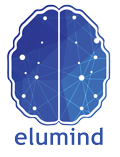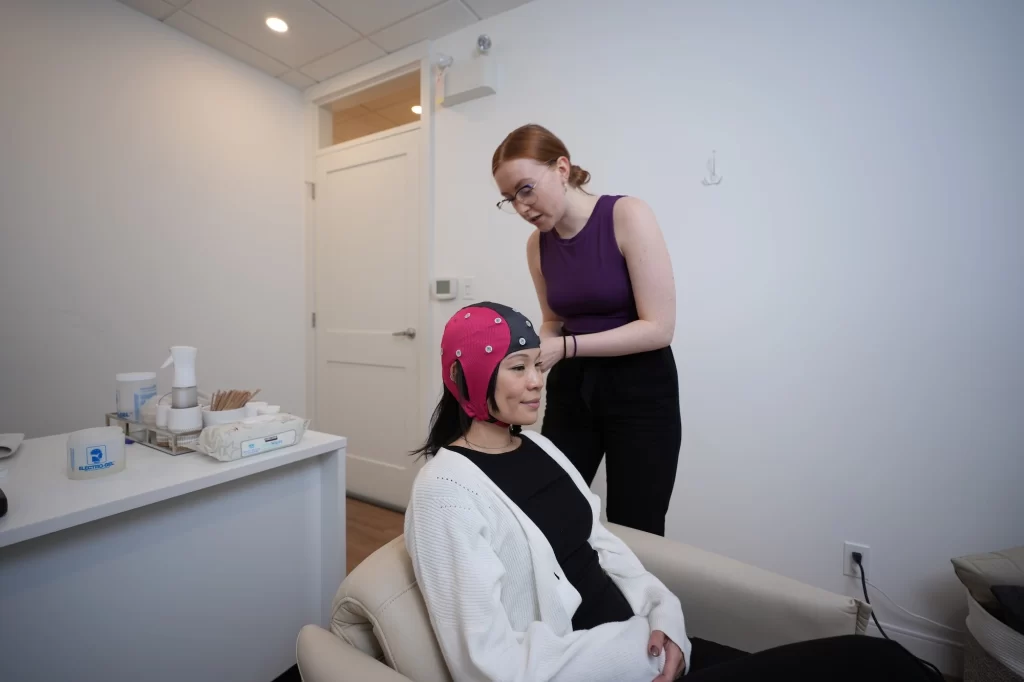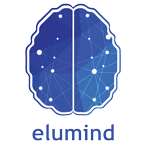Understanding your brain’s activity is key to improving mental health and cognitive performance. One cutting-edge tool that makes this possible is QEEG brain map. QEEG (Quantitative Electroencephalography) is essentially a “brain map” – a detailed analysis of the electrical activity in your brain. At Elumind, we use QEEG brain map to gain a deeper understanding of each client’s unique brain patterns, allowing us to tailor personalized treatment plans for optimal results.
In this blog, we’ll explain how QEEG works, what makes it different from traditional diagnostic tools, which conditions it can help identify (like anxiety, ADHD, depression, and more), and how it supports truly personalized, brain-based treatment planning. The goal is to demystify QEEG in an approachable way and show how Elumind integrates this tool into our holistic mental health programs.
What is QEEG Brain Map?
QEEG brain map is a comprehensive analysis of the brain’s electrical activity across various regions. In a QEEG assessment, we record your brain’s natural rhythms (brainwaves) and quantify the data to see how your brain is functioning. This approach looks at dozens of brain areas (Elumind examines 55 specific sites) to identify both the strengths of your brain and any areas that may be under- or over-active.
In simple terms, it’s like taking a functional snapshot of your brain: we can see which brainwave frequencies are dominating in which regions, and how well different parts of your brain are communicating. This detailed map of brain activity helps us understand how your brain’s performance might relate to your behaviors, emotions, and overall functioning.
Importantly, QEEG is a quick and efficient tool – the data gathering is relatively fast – and it often reveals underlying issues in the brain that might have gone unnoticed with traditional assessments.
By pinpointing these patterns, we get a “roadmap” of your brain that guides targeted interventions. In fact, advances in QEEG analysis now allow us to visualize deeper brain activity, further enhancing the accuracy of the brain map.
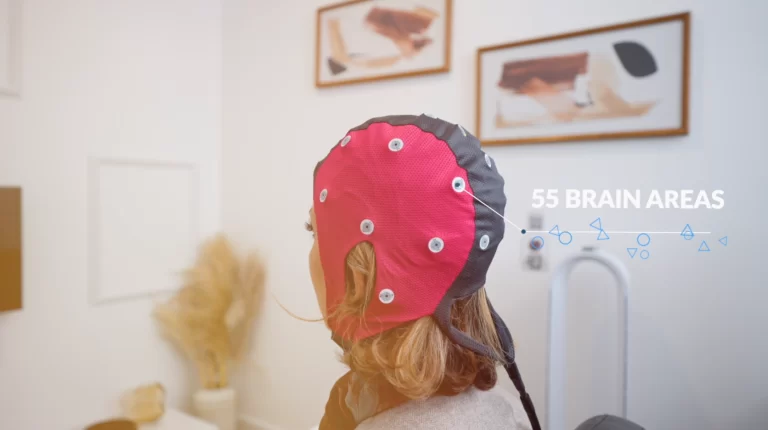
How Does QEEG Work?
In a QEEG brain map session, a client wears a cap with EEG sensors while their brainwave activity is recorded and displayed in real time. QEEG is a non-invasive and painless process. During a typical QEEG session, you sit comfortably while wearing a specialized cap fitted with sensors. These sensors detect the electrical signals produced by your brain cells (your brainwaves) at numerous sites across the scalp. The procedure is very similar to a standard EEG test, but with an important extra step. First, we record your brain’s activity — usually for a few minutes with eyes closed and then eyes open — to gather baseline data. This recording captures various brainwave frequencies (such as delta, theta, alpha, beta, gamma) associated with different states of consciousness. Once the data is collected, it is processed through advanced software that filters out artifacts (like eye blinks) and then compares your brainwave patterns to a large normative database of typical brain activity.
What Makes QEEG Different from Traditional Diagnostic Tools?
QEEG brain map offers insights that traditional diagnostic methods might miss. One major difference is the objective, functional data that QEEG provides. Unlike a typical evaluation that relies on questionnaires or observation of symptoms, QEEG directly measures how your brain is firing. It provides clear, quantifiable information about what’s happening in your brain, which can be especially valuable if your condition is complex or hasn’t responded to standard treatments. In other words, it takes out a lot of the guesswork.
Another key difference is that QEEG looks at brain function in real time, whereas many traditional brain imaging tools look at structure. For example, an MRI or CT scan can show if there’s a tumor or physical injury in the brain, but they don’t show how your brain is working. Those scans might appear “normal” even if you’re experiencing significant cognitive or emotional symptoms. QEEG, on the other hand, can reveal functional issues that an MRI cannot detect, such as abnormal brainwave patterns or connectivity problems. It effectively bridges the gap between purely symptom-based diagnosis and high-level brain imaging by providing a functional brain-based assessment.
To illustrate, consider attention difficulties: Traditionally, diagnosing a condition like ADHD might involve interviews and behavior checklists. While those are important, they don’t tell us what the brain is doing. A QEEG can objectively show, for instance, if the frontal lobes are underactive or if there’s an excess of slow-wave activity – concrete evidence of the brain’s role in the attention problems. In summary, QEEG’s quantitative brain map adds a layer of scientific measurement to mental health assessment that improves accuracy and personalization.
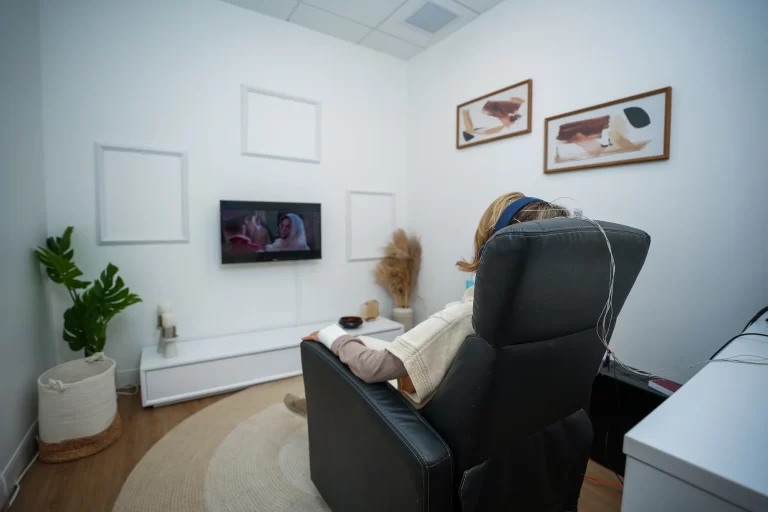
Conditions QEEG Can Help Identify
One of the exciting benefits of QEEG brain map is its ability to highlight patterns associated with various neurological and psychological conditions. By examining your brain map, clinicians can often tell which areas might be linked to specific symptoms. Here are some conditions for which QEEG can provide valuable insights:
- ADHD (Attention-Deficit/Hyperactivity Disorder): Individuals with ADHD often show distinctive brainwave patterns. For example, a person with ADHD may produce an abundance of slower theta waves in their frontal cortex (the brain region responsible for focus and decision-making). This slowed activity correlates with difficulty in sustaining attention. QEEG is considered one of the most accurate tools because it provides objective data to supplement evaluations, giving a clear picture of how the person’s brain is functioning. In fact, a QEEG brain map can distinguish ADHD-related brain patterns from those of other conditions, ensuring the individual gets the right diagnosis and a targeted treatment plan.
- Anxiety Disorders: Anxiety can manifest in the brain as specific patterns of overactivity or dysregulation. A QEEG map allows us to identify the nature of a person’s anxiety. It’s the excessive fast-wave activity generalized (as in Generalized Anxiety Disorder), or does the brain show a pattern consistent with past trauma (as we often see in PTSD)? Remarkably, QEEG can reveal if a brain is presenting features of PTSD versus general anxiety. For example, we might see overactive fear-processing circuits in someone with PTSD-related anxiety. Knowing this difference is crucial – it means treatment can be tailored appropriately (for instance, incorporating trauma-focused therapy for PTSD patterns, versus relaxation and cognitive techniques for general anxiety). By pinpointing the unique signature of an individual’s anxiety, QEEG helps ensure that interventions address the root cause of their worry or fear.
- Depression and Mood Disorders: Depression isn’t just an emotional state; it has correlating brainwave patterns. QEEG often shows dysregulated activity in regions of the brain that regulate mood in people who are depressed. For instance, some individuals with depression have an imbalance between the activity of the left and right frontal lobes, or generally lower activation in the frontal regions (which can be associated with low mood and motivation). A brain map makes these patterns visible. This insight gives both clinician and client a more concrete understanding that the depression has a physiological component – it’s not “all in your head” in the colloquial sense, but rather in your brain’s circuitry. By identifying such irregularities, QEEG can guide targeted treatments (for example, neurofeedback to increase activity in a underactive region implicated in mood, or other brain stimulation techniques to rebalance activity). Seeing a visual representation of the depression-related pattern can also be empowering for clients, as it provides validation and hope that training the brain could improve their mood.
(QEEG can also provide insights into other conditions. For example, with Autism Spectrum Disorder, QEEG may reveal atypical connectivity or imbalances in certain brain networks involved in sensory processing and social communication. In cases of memory disorders or dementia, QEEG might show slowing of brain activity in areas responsible for memory. For traumatic brain injuries (TBI) or post-concussion symptoms, a brain map can pinpoint regions with abnormal slowing or asymmetry as a result of the injury, which helps in planning cognitive rehabilitation. Even sleep disorders like chronic insomnia can be investigated with QEEG by looking at the brain’s arousal patterns. In all these cases, QEEG acts as a lens into brain function, adding valuable information to the overall diagnosis and treatment approach.)

The Benefits of QEEG Brain Map
By now, it’s clear that QEEG offers many advantages. Let’s summarize some key benefits you get from a QEEG brain map, especially when done with Elumind’s integrated approach:
- Targeted Training and Treatment: The QEEG analysis shows where your brain may need improvement. By analyzing your brain waves and map them, we can pinpoint cognitive or emotional brain areas that are not performing optimally. This means we can target specific areas of your brain for training, rather than a one-size-fits-all approach. For example, if the map indicates a weakness in frontal lobe activity (affecting focus), we know to direct training to that region. This targeted approach can make interventions like neurofeedback much more effective.
- Reduced Guesswork (Saving Time and Money): QEEG takes the guesswork out of treatment planning. Traditionally, finding the right therapy or medication for a mental health issue can involve trial and error. With a brain map, we have concrete data indicating what the problem areas are, so we can focus the treatment plan accordingly. This streamlined, data-driven approach can save you considerable time (and expense). In practical terms, if we see the brainwave dysregulation is linked to anxiety rather than, say, attention, we won’t waste time on an ADHD treatment path and will zero in on anxiety-focused interventions from the start.
- Personalized and Effective Treatment Plan: Because QEEG provides a detailed profile of your brain function, it allows for a highly personalized treatment plan. The insights from the brain map are often applied directly to neurofeedback or other brain-based therapies to create a planned and coordinated program for improving your brain’s performance. This means every session is tailored to your specific brain patterns, much like a custom exercise regimen for your brain. Over the course of training, as the targeted areas are exercised and optimized, clients often experience faster and more pronounced improvements in their symptoms. Essentially, QEEG helps ensure you are training the right thing in your brain, which can accelerate progress and lead to better outcomes.
- Holistic, Integrated Care: Another benefit of getting a QEEG brain map at Elumind is that it opens the door to our wider integrated brain health programs. The brain map doesn’t exist in isolation; it becomes part of a comprehensive healing strategy. With the knowledge gained from your QEEG, you can take advantage of various complementary therapies we offer – for example, Neurofeedback, Biofeedback, Transcranial Magnetic Stimulation (TMS), Photobiomodulation (PBM), counseling, nutritional guidance, and more – all coordinated to support your unique needs. In short, QEEG serves as a foundation for integrative training, ensuring that each aspect of your treatment is informed by your brain’s data. This integrated approach means we are addressing mind and body together, which can create lasting lifestyle changes and improvements in your well-being.

Conclusion
QEEG brain map is revolutionizing the way we approach mental health and brain wellness. By providing a window into the live functioning of your brain, it enables a level of personalized care that traditional approaches alone can’t achieve. The benefits of QEEG range from more accurate diagnoses to targeted treatments whether you’re dealing with anxiety, ADHD, ASD, PTSD, OCD, dementia, depression, or a host of other conditions. It’s a tool that brings neuroscience directly into the training room – making brain health less of a guessing game and more of a tailored journey.
At Elumind, we believe that understanding the brain is the key to unlocking lasting improvements in mental health. That’s why QEEG brain map is an integral part of our practice. We are a private, integrative brain health center that specializes in optimizing brain function through various evidence-based neurotherapeutic modalities. In plain terms, we combine the best of technology and holistic care – from QEEG and neurofeedback, biofeedback, TMS, PBM to functional medicine – to create a comprehensive, personalized program for each client. Our goal is not just to alleviate symptoms for the moment, but to foster long-lasting changes in the brain and lifestyle that empower you to thrive.
If you’re curious about your own brain’s map, we invite you to take that first step. At Elumind, our team is ready to guide you through the process – from the initial QEEG assessment to the tailored interventions that follow. With your brain’s unique map in hand, you’ll be better equipped to conquer your challenges and achieve the mental wellness you deserve. After all, when you can see the roadmap of your mind, you can more effectively navigate the road to feeling better. Here’s to unlocking your brain’s potential with QEEG brain map – a smarter approach to mental health that puts you (and your brain) at the center of the solution.

